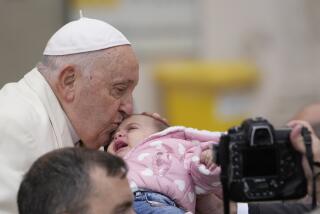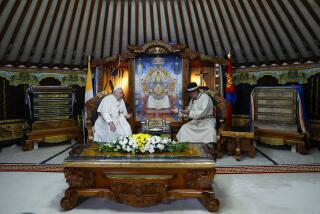Pope Francis travels to mosque in heart of sectarian conflict
- Share via
Reporting from Johannesburg, South Africa — The final hours of Pope Francis’ African tour might well have been most dangerous moments of his papacy, as he visited a volatile Muslim neighborhood in the Central African Republic’s capital, Bangui, followed by an open air Mass at a stadium.
It was the most powerful, symbolic moment of his Africa trip, as he became the first pope in modern history to travel to a war zone.
As crowds cheered, Francis brushed aside security warnings, traveling in the back of an open Pope-mobile -- a converted SUV with no bulletproof glass -- and wore no bulletproof vest.
It was a trip that the French Defense Ministry had urged against, saying forces from the former colonial power couldn’t guarantee the pontiff’s safety.
But it sent an inspiring message of hope and peace to Christians and Muslims in a nation that has been locked in a cycle of sectarian violence since December 2012.
Francis met Muslim leaders at the Koudoukou mosque in the Muslim enclave, PK5 -- the only remaining Muslim residential neighborhood in the capital -- which is blockaded by Christian militias, preventing residents from leaving.
U.N. peacekeepers stationed in the landlocked African country and Vatican security guarded the pontiff during his visit, the former stationed in the mosque’s minarets during the visit.
Peace and interfaith dialogue has been the central themes of the pope’s visit to Africa. Francis said his trip would not have been complete had he failed to meet with the Muslim community in PK5.
During his visit to Koudoukou mosque, he said Christians and Muslims were brothers and denounced violence, particularly attacks committed in the name of religion.
“Christians and Muslims and members of traditional religions have lived peacefully for many years. Together, we say no to hatred, to vengeance and violence, especially that committed in the name of a religion or God,” the Associated Press quoted Francis as saying.
“In these dramatic times, Christian and Muslim leaders have sought to rise to the challenges of the moment. They have played an important role in reestablishing harmony and fraternity among all.”
He called for leaders “capable of bringing Central Africans together, thus becoming symbols of national unity rather than merely representatives of one or another faction.”
When he arrived in the Central African Republic on Sunday, the pope said he was visiting as a “pilgrim of peace and an apostle of hope.”
Half a million people, mainly Muslims, have fled the country amid a conflict that saw a coalition of Muslim rebels known as Seleka forces oust President Francois Bozize in 2013.
Christian militias known as anti-balaka fighters battled back, carrying out revenge attacks against Muslim communities. Rebel leader Michel Djotodia resigned the presidency last year to make way for an interim government, headed by interim President Catherine Samba-Panza, but violence continues.
The pope’s visit to the PK5 enclave was such a security risk that it remained in doubt until it happened.
Lewis Mudge, Africa researcher for Human Rights Watch, described it as “an extraordinary moment,” sending a message that respect for both Muslims and Christians was the key to ending the conflict.
PK5, once a bustling Muslim neighborhood of about 122,000, has declined to an isolated, fearful core of just 15,000 people after most residents fled to escape sectarian attacks. In recent weeks, more than 100 residents have been killed in a surge of violence, according to Human Rights Watch.
The rights group used satellite imagery to determine that more than 1,000 homes and other buildings have been destroyed since late September.
“Many of those killed were civilians, including women and the elderly. They were stabbed to death, their throats were slit, or they were shot at close range,” according to a Human Rights Watch statement last week.
After visiting the mosque, Francis delivered an open air Mass at the city’s Barthelemy Boganda stadium. Members of the crowd -- many of them wearing clothing bearing his picture and carrying yellow and white umbrellas, the colors of the Holy See -- cheered when he arrived.
He then departed for the airport before flying home to Rome.
Follow @robyndixon_LAT on Twitter for news out of Africa
More to Read
Sign up for Essential California
The most important California stories and recommendations in your inbox every morning.
You may occasionally receive promotional content from the Los Angeles Times.










